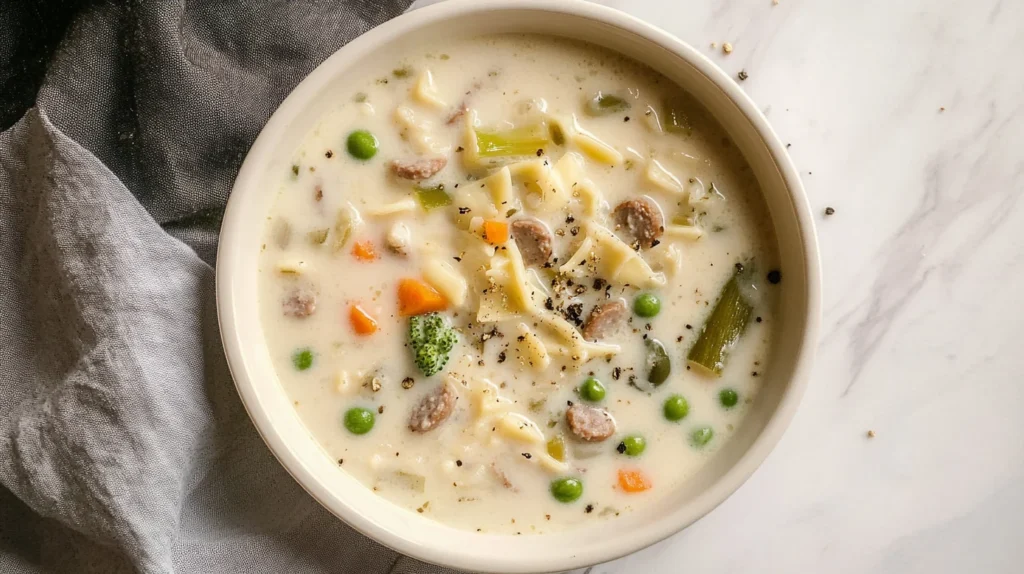When cooking, you want your cream soups to be rich and satisfying. Learning to make them thick is key. It’s a challenge, but with the right methods and ingredients, you can achieve delicious, hearty soups. Whether you’re new to cooking or experienced, knowing how to control the consistency of cream soups is essential.
Exploring cream soups reveals that thickening them is an art. It takes patience, practice, and the right techniques. You’ll learn from traditional flour-based methods to advanced techniques for professional-style soups. This guide will share tips and techniques for thickening cream soups, including the best ingredients to use.
Related : Creamy Parmesan Italian Sausage Soup Recipe
Introduction to Thickening Cream Soups
Thickening cream soups is vital for creating delicious soups. By mastering the art of thickening, you can make soups for any occasion. With the right techniques and ingredients, you can achieve soups that are rich, creamy, and full of flavor.
Key Takeaways
- Learning how to make cream soups thick is essential for creating delicious and satisfying soups.
- Understanding the basics of cream soup consistency is crucial to making great soups.
- Thickening cream soups requires patience, practice, and the right techniques.
- Traditional flour-based methods are a great way to thicken cream soups.
- Advanced techniques, such as reduction and emulsion, can be used to create professional-style thickness.
- Using the right ingredients, such as heavy cream and cheese, can help to thicken cream soups.
Understanding the Basics of Cream Soup Consistency
Creating delicious cream soups means getting the consistency right. You want it smooth and creamy, not too thick or thin. To get it just right, you need to know how to thicken soups. This includes reducing liquid or adding starches for a rich texture.
Exploring cream soups shows that consistency is more than looks. It’s about flavor and texture too. A great soup balances all its flavors well. Learning to thicken soups helps you make them both tasty and beautiful.
What Makes a Perfect Cream Soup
A perfect cream soup is smooth, creamy, and full of flavor. To get this, you can reduce liquid, add starches, or use emulsifiers. Techniques like making a roux or adding cornstarch can help thicken the soup.

The Science Behind Soup Thickening
Thickening soups is all about chemistry and physics. Adding starch or flour makes the soup thicker by absorbing liquid. This process, called gelatinization, is key to a smooth soup.
Common Consistency Problems
One big problem in soups is them being too thin or thick. This can happen if you use the wrong amount of liquid or don’t cook it enough. To fix this, use the right amount of liquid and cook it for the right time. With these tips, you can make soups that are both delicious and satisfying.
Traditional Flour-Based Thickening Methods
Thickening cream soups often involves using flour for thickening soup. This method mixes flour with butter or oil to make a roux. Then, the roux is whisked into the soup. Cooking it for a few minutes removes any raw taste and thickens the soup.
To effectively use flour for thickening soup, creating a smooth roux is key. Whisk it into the soup slowly to avoid lumps. You can also make a slurry from flour and water or broth. This is handy when you’re in a hurry or don’t want to make a roux.

Using flour for thickening soup is easy and affordable. It also adds a rich, velvety texture. But, it can make the soup taste starchy, which might not be what you want. Knowing the pros and cons helps you decide when and how to use flour.
Here are some tips for using flour for thickening soup:
- Choose a fresh, high-quality flour.
- Make a smooth roux by cooking the flour and fat mixture for a few minutes, stirring constantly.
- Whisk the roux into the soup gradually, to avoid lumps.
- Use a slurry made from flour and water or broth as an alternative to making a roux.
Using Cornstarch and Other Starches
Cornstarch is a favorite for thickening soups. It’s simple to use and works well. To thicken, mix cornstarch with cold water or broth to make a slurry. This slurry is then added to the soup to avoid lumps.
Other starches like tapioca or arrowroot can also thicken soups. Starches are versatile and can be used in many dishes. Here are some points to consider:
- Benefits: easy to use, effective, and relatively inexpensive
- Drawbacks: can create a starchy flavor, and can be prone to lumping if not mixed properly
To use starches right, follow the right measurements and timing. Use 1-2 tablespoons of cornstarch or other starch per cup of liquid. Adjust as needed for the right consistency.
Learning to use cornstarch and other starches can make soups smooth and creamy. With practice and patience, you’ll get the perfect soup consistency.
| Starch | Benefits | Drawbacks |
|---|---|---|
| Cornstarch | Easy to use, effective | Can create a starchy flavor |
| Tapioca | Neutral flavor, easy to digest | Can be expensive |
| Arrowroot | Gluten-free, easy to use | Can be prone to lumping |
How to Make Cream Soups Thick with Natural Ingredients
Thickening soups doesn’t always mean using flour or cornstarch. Many natural ingredients can help achieve the right consistency. Techniques for thickening soups with these ingredients are easy. Pureed vegetables like carrots, celery, or onions are great for thickening.
These veggies not only thicken the soup but also add flavor and nutrients. Coconut cream is another excellent choice, perfect for those who prefer dairy-free options. It can be mixed with water to create a slurry that thickens the soup.
Other natural ingredients for thickening include:
- Pureed potatoes
- Cooked and mashed beans
- Nut butters, such as peanut or almond butter
Using natural ingredients to thicken soups offers several benefits. It adds flavor and nutrients, and avoids refined starches and flours. These ingredients are often high in calories and low in nutrients. By using these techniques for thickening soups, you can make delicious, healthy soups for any occasion.
Here is a simple table to help you get started with natural thickening agents:
| Ingredient | Ratio to Liquid | Instructions |
|---|---|---|
| Pureed Vegetables | 1:2 | Mix with a little water to create a slurry |
| Coconut Cream | 1:1 | Mix with a little water to create a slurry |
| Pureed Potatoes | 1:2 | Mix with a little water to create a slurry |
Advanced Techniques for Professional-Style Thickness
To get your creamy soup to a professional level, you need to learn some advanced techniques. These methods will help you make soups that stand out. One key technique is reduction, where you cook the soup longer to make the flavors stronger and the soup thicker. This takes patience, but it’s worth it.
Another important technique is emulsion. Emulsions happen when you mix two liquids that don’t usually go together, like oil and water. In soups, emulsions make the texture creamy and stable. Learning how to make and keep emulsions adds depth to your soups.
Reduction Methods
- Cook the soup for a long time to make the flavors stronger
- Use low heat to avoid burning or sticking
- Stir the soup now and then for even thickening
Emulsion Techniques
Emulsion techniques mix two liquids that don’t usually mix. To make a stable emulsion, you need an emulsifier like egg yolks or mustard. Knowing how to create and keep emulsions adds complexity and depth to your soups.
Temperature Control Tips
Controlling the temperature is key for professional-style thickness in creamy soups. It helps prevent the soup from being too thin or too thick. Cook the soup at low heat and stir occasionally for even thickening.
Common Mistakes to Avoid When Thickening Soups
Thickening cream soups can be tricky. Common mistakes can mess up the whole dish. You aim for a perfect mix of flavors and textures. But, over-thickening or under-thickening can really throw things off.
To steer clear of these errors, keep a close eye on your soup’s consistency. Adjust the thickening agents as needed. Here are some common mistakes to watch out for:
- Adding too much thickening agent at once, leading to an over-thickened soup
- Not whisking the thickening agent properly, resulting in lumps in the soup
- Not cooking the soup long enough to allow the thickening agent to take effect
Knowing these common mistakes can help you make delicious, balanced soups. Always check the soup’s consistency and tweak the thickening agents to get it just right.
With practice and patience, you’ll get better at thickening soups. Soon, you’ll be whipping up tasty dishes that everyone will love.
| Mistake | Solution |
|---|---|
| Over-thickening | Whisk in a small amount of liquid to thin out the soup |
| Under-thickening | Whisk in a small amount of thickening agent to thicken the soup |
Dairy-Based Thickening Solutions
Dairy-based solutions are perfect for making soups creamy. You can use heavy cream, cheese, yogurt, or sour cream. For instance, heavy cream is great for a creamy parmesan italian sausage soup.
Dairy thickening solutions add flavor to soups. Cheese is excellent for soups, adding a rich texture. Yogurt or sour cream can give a tangy taste.
Heavy Cream Applications
Heavy cream is a top choice for thickening soups. It’s perfect for creamy soups like parmesan italian sausage soup. Just stir it in at the end and simmer for a few minutes to thicken.
Using Cheese as a Thickener
Cheese is great in soups and can thicken them. Grated cheese, like parmesan or cheddar, melts and adds flavor and thickness when stirred in at the end.
Yogurt and Sour Cream Methods
Yogurt and sour cream are also good for thickening soups. They add a tangy taste and help thicken. Just stir them in at the end and simmer for a few minutes.
| Dairy-Based Thickening Solution | Benefits | Drawbacks |
|---|---|---|
| Heavy Cream | Rich and creamy texture, adds flavor | High in calories, can be expensive |
| Cheese | Adds flavor and thickness, can be used in a variety of soups | Can be high in calories, may not be suitable for all diets |
| Yogurt and Sour Cream | Adds tangy flavor, can help to thicken soups | May not be suitable for all diets, can be high in calories |
Gluten-Free Thickening Alternatives
There are many ways to thicken cream soups, not just using flour. For those who can’t have gluten, gluten-free thickening alternatives are perfect. They work well and are safe for those with dietary needs.
Popular choices include cornstarch, tapioca flour, and potato starch. You mix them with a little water to make a slurry. Then, add it to your soup to thicken it. You can also use gluten-free flours like rice or almond flour.
- Cornstarch: a common gluten-free thickening alternative that is easy to use and effective
- Tapioca flour: a versatile ingredient that can be used to thicken soups and create a creamy texture
- Potato starch: a gluten-free alternative to traditional flour that is high in starch and low in protein
Using gluten-free thickening alternatives might take some practice. But, with a bit of effort, you can get your soups just right. Always mix your thickening agent with water first. Then, cook the soup for a few minutes to let it thicken.
Adding gluten-free thickening alternatives to your cooking can make meals safe and tasty for everyone. With some trial and error, you’ll get the hang of it. Soon, you’ll be making creamy, delicious soups for all to enjoy.
| Gluten-Free Thickening Agent | Ratio to Liquid | Cooking Time |
|---|---|---|
| Cornstarch | 1:2 | 5-7 minutes |
| Tapioca Flour | 1:3 | 10-12 minutes |
| Potato Starch | 1:2 | 5-7 minutes |
Conclusion: Mastering the Art of Cream Soup Thickness
Mastering the art of cream soup thickness is a fun journey. You’ll learn many ways to thicken soups. This includes using flour, starches, and natural agents to make soups look and taste great.
If you love cooking or just want to make better soups, this guide is for you. It teaches you how to fix common problems and try new techniques. The most important thing is to enjoy the process.
The secret to a perfect cream soup is finding the perfect mix of creaminess and texture. Use what you’ve learned from this article to make soups that wow everyone.
Now, it’s time to get creative in the kitchen. Show off your soup-making skills. With a bit of practice, you’ll soon be a pro at making cream soup thickness just right.
FAQ
What makes a perfect cream soup?
A perfect cream soup is silky and velvety. It’s rich and creamy. The goal is to balance creaminess and thickness for a delicious, easy-to-enjoy soup.
What is the science behind soup thickening?
Thickening soup involves gelatinizing starches and emulsifying fats. Adding flour or cornstarch makes the soup thicker. Dairy products like heavy cream or cheese also help thicken through emulsion.
What are the common consistency problems with cream soups?
Common issues include soups that are too thin or too thick. Separation and graininess can also happen. These problems come from not mixing thickening agents right.
How can I use flour to thicken my cream soup?
To thicken with flour, make a roux. Cook flour and fat together until the flour taste goes away. Then, whisk the roux into the hot soup for a smooth texture.
What is the cornstarch slurry technique for thickening soups?
The cornstarch slurry method mixes cornstarch with cold liquid. This creates a smooth mixture. Whisk it into the hot soup to thicken without lumps.
What are some alternative starch options for thickening soups?
Other starches like tapioca flour, arrowroot powder, or potato starch can thicken soups. They offer different textures and are good for dietary restrictions.
How can I use natural ingredients to thicken my cream soup?
Natural thickeners include puréed veggies like potatoes or cauliflower. Coconut cream or milk also add body and creaminess without traditional agents.
What are some common mistakes to avoid when thickening soups?
Avoid over- or under-thickening. These can make the soup too dense or too thin. Also, mix thickening agents well to avoid lumps and check the soup’s consistency as it cooks.
How can I use dairy products to thicken my cream soup?
Dairy like heavy cream, cheese, yogurt, or sour cream can thicken soups. Heavy cream adds directly, while cheese melts for a creamy texture. Yogurt and sour cream add thickness and tanginess at the end.
What are some gluten-free thickening alternatives for cream soups?
For gluten-free diets, use cornstarch, tapioca flour, or xanthan gum. These work like traditional agents but don’t have gluten.

